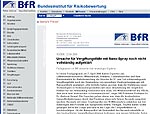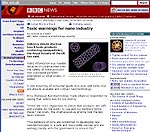Nano Technology - Possible New ' Health Disaster' of the 21st Century?
In the same way as Asbestos and Smoking became the health disaster of the 20th amid denials for over 30 years of any health risks, it appears that the new emerging Nano technology may present a similar health disaster in this century.
In April this year the first Nano-technology based consumer product recall took place in Germany, whilst at the same time the Woodrow Wilson International Center for Scholars, a U.S. based institution, has produced an inventory of more than 200 consumer products which contain nanotechnology.
The Washington Post report in April concerned the recall in Germany of a product called
"Magic Nano", a bathroom cleansing product, following at least 97 people reporting severe respiratory problems over a one-week period in March - including six who were treated in hospital with pulmonary edema, or fluid in the lungs - as reported by the Federal Institute for Risk Assessment in Berlin. Symptoms generally cleared up within 18 hours, though some had persistent breathing problems for days.
In addition in March this year, the same authority issued warnings regarding the use of sealing sprays for glass and ceramics containing moisture-repellant nano particles and a propellant should not be used in confined spaces.
 The press release on their website said, "The Federal Institute for Risk Assessment has good reason for pointing this out. In a short space of time the poison control and treatment centres of the federal states have reported 39 cases involving serious health disorders following the use of household products of this kind. All the people involved complained of respiratory distress. In six cases pulmonary oedemas were diagnosed which had to be treated in hospital."
The press release on their website said, "The Federal Institute for Risk Assessment has good reason for pointing this out. In a short space of time the poison control and treatment centres of the federal states have reported 39 cases involving serious health disorders following the use of household products of this kind. All the people involved complained of respiratory distress. In six cases pulmonary oedemas were diagnosed which had to be treated in hospital."
Sealing sprays with nano particles for ceramic and glass surfaces are a new type of household chemical. In the bathroom and toilet they are said to make surfaces water and dirt-repellent. Liquids are said to trickle off without leaving behind any rings or lime spots. This product is sold in pump bottles and aerosol cans.
The
BfR gathers up-to-date information on nano particles in consumer-related application areas and issues consumer guidance on the health aspects of using the products in Germany.
Meanwhile, here in the UK, concerns where raised as far back as July 2004
when The Royal Society and Royal Academy of Engineers' report recommended tighter UK and European regulation over some aspects of the tiny science, which
manipulates molecules and even atoms to make novel materials.
The potential in this emerging research field is huge but there are also concerns that some new products may have unexpected and damaging effects on human health and the environment, with the "Magic Nano" product being just one example of what may soon become a long list.
There are no health and safety standards of production in nano technology: "The UK needs safety and regulatory systems that address public aspirations and concerns and which command public confidence during the development of nanotechnologies," Lord Sainsbury, Science Minister, said in a speach at
the opening of a major new nano exhibition at London's Science Museum in February 2005. This was in response to the Royal Society and Royal Academy of Engineers' July 2004 report which said
that there were uncertainties about the effects of free nanoparticles on health and the environment, and recommended tighter UK and European regulation over some aspects of the tiny science.
Since then nothing further has happened, but further calls of concern appeared again only this week.
 Professor Ann Dowling of
The Royal Society, an academy of leading scientists, commented on the fact that some 200 consumer products such as laptops, cosmetics and stain-resistant clothing use nanotechnology saying,
Professor Ann Dowling of
The Royal Society, an academy of leading scientists, commented on the fact that some 200 consumer products such as laptops, cosmetics and stain-resistant clothing use nanotechnology saying,
"We are calling for industry to put the methods they use to test the safety of products containing free nanoparticles, such as some cosmetics, into the public domain because this is one particular area where there is some uncertainty about safety."
Free nanoparticles are not fixed or etched to a larger object but move around. The Royal Society has expressed concern that free nanoparticles could be inhaled, ingested or enter the body through the skin and damage cells.
"Nanoparticles can behave quite differently from larger materials of the same substance and it is these properties that many manufacturers seek to take advantage of," Dowling said.
She added that more openness between industry and scientists could lead to agreed testing methods.
Del Stark of the European Nanotechnology Trade Alliance (ENTA) said it was working with the government and committed to developing new nanotechnologies in a safe and responsible manner.
"There are strict regulations, which include approved and standard tests such as skin irritation, tissue culture, phototoxicity and assays, to check that products are safe and suitable for the public to use and our members follow these," he said in a statement.
Health concerns are real as
Nanoparticles are generally understood to be particles below 100nm in size - about 1/ 80,000 of a human hair - that take advantage of the quantum effects (property changes that occur at the nano-scale). In general, nanoparticles of 70 nm can enter the lungs while a 50nm particle can enter cells and a 30 nm particle can pass through the blood/brain barrier.
In the US, ETC Group (Action Group on Erosion, Technology and Concentration) claim "There are scores of products out there whose nano-scale ingredients are escaping regulatory review and they include anti-wrinkle creams, sunscreens, chocolate diet shakes, tooth powder, pesticides, cooking oil, vitamin supplements and more."
Concern exists also for the use of nano particles in the Food industry where there is no transparency as to how they are used and in what food products they are contained. Certainly in the US new and novel foods are being developed using the technology.
Sadly in the UK, the Government's Food Standards Agency appears to be silent on the issue.
Source:
Federal Institute for Risk Assessment Berlin, The Environmental News Network, BBC News, Washington Post, ETC Group.